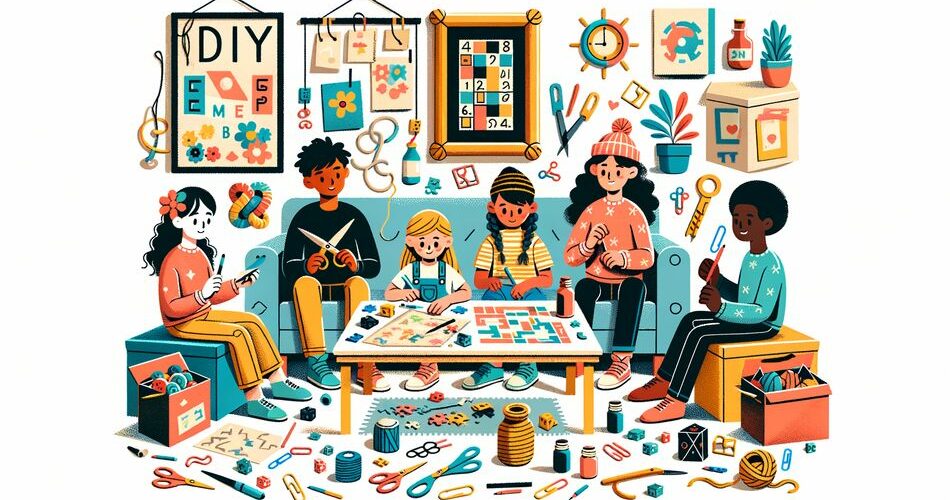When it comes to family activities, there’s nothing quite like a hands-on experience that fosters both fun and learning. DIY escape rooms offer an exhilarating blend of adventure, mystery, and teamwork. They have surged in popularity for their ability to engage all family members, from young children to teenagers, and provide a unique opportunity to work together in solving puzzles and finding hidden clues. If you’re in search of an exciting way to bond with your family, crafting your own escape room at home could be the answer.
Why Create a DIY Escape Room?
DIY escape rooms are an exceptional family activity for several reasons:
- Team Building: Solving puzzles requires collaboration, communication, and collective brainstorming. These are invaluable skills that can enhance family dynamics.
- Educational Fun: Puzzles can be tailored to focus on educational content, such as math problems, historical trivia, or language skills, making learning enjoyable.
- Customization: The challenge can be customized to fit the age and abilities of participating family members, ensuring everyone can contribute.
- Affordability: Creating an escape room at home can be cost-effective compared to commercial escape room venues.
Getting Started: Planning Your DIY Escape Room
To kick off your DIY escape room, follow these foundational steps:
- Choose a Theme: Themes bring coherence to the puzzles and make the experience more immersive. Consider themes like a pirate treasure hunt, a haunted house, or a spy mission.
- Set the Scene: Decorate the room to match the theme. Use household items, props, and costumes to create an ambiance that immerses participants in the story.
- Define Goals: Establish a clear objective for participants, such as finding a hidden key or solving a final riddle, to “escape” the room.
Creating the Puzzles
The core of any escape room experience is its puzzles. Here are some fundamental types of puzzles to incorporate:
- Locks and Keys: Hide keys in secret places and use different types of locks (padlocks, combination locks) that require solving a puzzle to open.
- Ciphers and Codes: Use codes and ciphers that need decoding, such as Morse code, Caesar ciphers, or invisible ink messages.
- Physical Puzzles: Incorporate jigsaw puzzles, pattern matching, or mazes that need to be completed to find the next clue.
- Word and Number Puzzles: Create riddles, crosswords, or Sudoku puzzles that need to be solved to progress.
Make sure the puzzles vary in difficulty to sustain engagement for all age groups. For younger children, include simpler activities like matching or color-based puzzles. For teens, increase the complexity and introduce logical or abstract reasoning challenges.
Testing and Adjusting
Prior to the family embarking on the escape room adventure, it’s crucial to test the entire setup:
- Trial Run: Perform a trial run to ensure that all puzzles are solvable and the sequence is logical.
- Adjust Difficulty: Adjust the difficulty level based on the trial run. Ensure that the experience is neither too easy nor too frustrating.
- Prepare Hints: Have a system in place for offering hints without directly giving away answers if participants get stuck.
Embarking on the Adventure
Once everything is set, gather the family and explain the rules and the storyline. Start the clock and let the adventure begin! Here are some tips to keep the energy high:
- Encourage Communication: Remind participants to communicate openly and share their discoveries.
- Facilitate Cooperation: Emphasize the importance of working together and valuing each other’s contributions.
- Celebrate Successes: Celebrate small victories along the way to keep morale high and everyone motivated.
Reflecting on the Experience
After completing the escape room, take some time to reflect on the activity:
- Discuss: Talk about what strategies worked, what was challenging, and what everyone enjoyed the most.
- Feedback: Gather feedback to improve the next DIY escape room experience.
- Celebrate Together: End with a fun celebration to commend the team effort, such as a special dinner or movie night.
Conclusion
DIY escape rooms are more than just a pastime; they’re a creative way to strengthen family bonds, develop critical thinking skills, and have loads of fun. By tailoring the experience to fit your family’s unique dynamic, you create lasting memories and foster a sense of teamwork and accomplishment. So, roll up your sleeves, bring out your inner game master, and dive into the exciting world of DIY escape rooms with your family!

